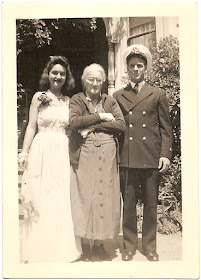Weddings are always happy occasions—unless, of course, you are
the one who is paying for them.
Imagine the situation of one William James Shields, farmer,
of various counties in northern California
in the late 1800s. As was common for those times, William was the proud father
of many children—among them, five daughters.
Moving his family west from Illinois
in 1873, he settled them first in Marin County—the region, today, contiguous
to the northern end of the Golden Gate Bridge.
Not satisfied with his property just six miles south of what is now the city of
Petaluma, he purchased acreage farther south, in San Benito County, and moved
his family there in 1875.
By that time, Daughter Number One was nearing seventeen
years of age.
If San Benito
was the wide-open country of rolling hills and grazing land that it appears to
be now, farming might have been just fine, but prospects for suitors most
likely appeared dismal.
Perhaps that was not at the forefront of Mr. Shields’ mind
when he opted to cash in on his property in San Benito a little over a year
later, but the family’s move to San Mateo County improved Daughter Number One’s
prospects considerably.
Announcements for Wedding Number One were soon made, and
Alice V. Shields assumed her new name upon being happily married to Thomas
Freeman Newell in 1877.
A lull in family happiness ensued—no doubt having nothing
whatsoever to do with the fact that Child Number Two was a son and not a
daughter. Neither would it have hinged upon the fact that father William
Shields had decided, once again, to purchase property elsewhere.
This time, the move was to far away Fresno County.
The date for the move was the year 1884.
It didn’t take long for Child Number Two to announce his
intentions, and a marriage—to young Elsie, she of the maiden name I’ve yet to
discover—followed in 1887.
Ripe for happiness, the now-settled farmer must have gone
nearly delirious with joy, as Daughter Number Three followed suit close upon
the heels of her brother, and—not to be undone—her just-older sister, Daughter
Number Two (you thought I had miscounted, didn’t you?) snagged her man not
seven months afterwards.
To recap: daughter Lillian Elizabeth Shields became the new
Mrs. George W. Taylor in November, 1988, soon taking up residence far to the
north in Mendocino County; and daughter Ella May Shields became the bride of
Leon Samuel Bean in Fresno on June first of 1889, returning to the San Mateo County
environs where her family had once resided.
Tally: four marriages, three to pay for.
Thankfully, all was followed by a peaceful seven years’
hiatus in which Papa Shields could regain whatever financial solvency he once
commanded.
Not to be outdone, for the family’s grand finale, youngest
daughter Flora bested her just-older sister Josephine by a scant thirty days,
marrying Frank Luman Montague in Fresno on November 25, 1896, making this the
family’s fifth wedding. Christmas Eve became the day of Josephine’s nuptials to
another Fresno
man, Wright Henry Spencer.
I can only imagine what a Christmas that must have been for
their father.
Above: Among the many unlabeled photographs in Bill Bean's collection, this unidentified young couple, dressed for a festive occasion, accompanies an elderly woman who looks very much like she might be Ella Shields Bean.

My family roots are in Fresno during the same time period as yours! My family name is Levy and my grandfather was one of 4 boys - I read your post with keen interest hoping maybe one of those daughters married one of my Levys. It will be interesting to find if our ancestors were connected in any way.
ReplyDeleteDebi, wouldn't that be something if we turned out to be connected through family lines! I'll have to keep my eyes open for info on Levy names while I sift through all the newspapers and documents related to Fresno.
DeleteWeddings were not a big "to do" like nowadays. Most likely the vows were said in the home and a dinner served afterwards..a wedding feast for all the relatives. The bride may have worn a new dress..white if the family was wealthy..black if they were not. Sometimes the bride sewed her own dress..or had a friend that sewed. My Husbands Grandparents were married on Christmas Day..but Christmas was different back then ..it revolved around Church and a few small gifts to be exchanged..socks, mittens, hankies, books, journals.. much simpler times. I will quit rambling now:)
ReplyDeleteOh, that's totally fine, Far Side--not rambling! I certainly trust your input on this. If anyone would know, it would be you!
DeleteOn the other hand...I just couldn't resist...
I often wonder about those weddings that came close together. But I suspect most in my family were those small ceremonies without fanfare.
ReplyDeleteI can understand the impetus for arranging those double ceremonies I've run across in researching some lines in my family. My thinking from our times: "Why would a bride want to share her day with another couple's ceremony?" Thinking back then: "We're family; why not spare the expense?"
DeleteAt least that's what I'd guess...